Venice Sights – Attrazioni di Venezia
- Maria Scuor
- Apr 26
- 20 min read
Italiano sotto ogni sezione
My first trip to Venice or Venezia in Italian and as I will call it going forward, was when I was very little with my parents and brother. Gianni and I have gone a few times alone and with friends and this visit we had our very dear friends Glenn and Kirsten from Canada therefore we took the four-hour drive from Arona to explore this incredible historic place with them.
Before getting into the history of this amazing city, I want to give you a piece of advice; GET UP EARLY! Yes, early enough to see the sunrise. Firstly, as you are walking through the city you can take amazing pictures of the architecture without the crowds and most important, the sunrise is spectacular with the gondolas in the background.
Il mio primo viaggio a Venezia è stato quando ero molto piccola con i miei genitori e mio fratello. Gianni ed io siamo andati un paio di volte da soli e con gli amici e questa visita abbiamo avuto i nostri carissimi amici Glenn e Kirsten dal Canada, quindi abbiamo preso le quattro ore di macchina da Arona per esplorare questo incredibile luogo storico con loro.
Prima di addentrarmi nella storia di questa meravigliosa città, voglio darvi un consiglio; ALZATI PRESTO! Sì, abbastanza presto per vedere l'alba. In primo luogo, mentre cammini per la città puoi scattare foto straordinarie dell'architettura senza la folla e, cosa più importante, l'alba è spettacolare con le gondole sullo sfondo.
There is so much to see and history in Venezia, that besides this blog, I’ve dedicated blogs to these sights that needed their own platform to do them justice
Venezia is a city in northeastern Italy and the capital of the Veneto region. The island city is built on a group of 118 islands that are separated by canals and open water and connected by foot bridges. There are about 52,000 people living on the island of Venezia and about 259,000 who reside in the Greater Venezia Comune.
The name came from the ancient Veneti people who lived in the region in the 10th century BC. For almost a millennium, from 810 to 1797, the city was the capital of the Republic of Venezia. Being on the water, it was a financial and maritime power during the Middle Ages and Renaissance periods. It traded in silk, grain, spice and art from the 13th to the end of the 17th century.
Venezia became the first real international financial centre around the 9th century and was at its dominance in the 14th century. It was a wealthy city throughout history and possessed numerous territories along the Adriatic Sea and within the Italian peninsula for centuries. This can be seen in the architecture and culture that we see today as well as the Venetian Arsenal (shipyard and armories) is considered by many historians to be the first factory in history.
However, Venezia’s sovereignty came to an end in 1797 when Napoleon conquered Venezia on May 12th during the War of the First Coalition. To the Jewish population, Napoleon was seen as a liberator, as he removed the gates of the Ghetto and allowed the Jews to travel the city. However, in October Napoleon sighed the Treaty of Campo Formio and Venezia became Austrian territory. Over the years it went back and forth from Austria to Napoleon but finally after the Third Italian War of Independence, in 1866, Venezia along with the rest of Veneto, became part of the newly created Kingdom of Italy.
Unlike many other cities in Italy, thankfully Venezia was saved large attacks during the World Wars and in 1987 Venezia and its Lagoon was listed as a UNESCO World Heritage Site. Of course, this is just a snippet of history that I’m sure I could write many more blogs about.
Venezia’s historic centre is divided into six sestieri or districts named; Cannaregio, Castello, Dorsoduro, San Marco, San Paolo and Santa Croce. Some times the centre becomes flooded by “Acqua Alta” or high waters and planks have to put up to walk out of the water. More about this is found in my Venezia Canals blog (link above).
Getting to the Island
There are NO cars allowed on the island therefore we can walk about ½ an hour but would probably take a lot longer because there would be so much to see, or we can get there by train which stops at Santa Lucia railway station. We parked our car in one of the many parkades on the mainland and hopped on a water bus or vaporetto, which is a boat that takes us to Piazza San Marco. From there we can hop on many other boats that can take us to the other islands.
Photos of sights on our boat ride – Foto delle attrazioni durante il nostro giro in barca
C'è così tanta storia e da vedere a Venezia, che oltre a questo blog, ho dedicato dei blog a queste attrazioni che avevano bisogno di una piattaforma propria per rendere loro giustizia.
Venezia è una città dell'Italia nord-orientale e il capoluogo della regione Veneto. La città insulare è costruita su un gruppo di 118 isole separate da canali e acque libere e collegate da ponti pedonali. Sono circa 52.000 le persone che vivono sull'isola di Venezia e circa 259.000 che risiedono nel Comune di Venezia Maggiore.
Il nome deriva dall'antico popolo dei Veneti che viveva nella regione nel X secolo a.C. Per quasi un millennio, dall'810 al 1797, la città fu la capitale della Repubblica di Venezia. Essendo sull'acqua, fu una potenza finanziaria e marittima durante il Medioevo e il Rinascimento. Commerciava in seta, grano, spezie e arte dal XIII alla fine del XVII secolo.
Venezia divenne il primo vero centro finanziario internazionale intorno al IX secolo e raggiunse il suo apice nel XIV secolo. È stata una città ricca nel corso della storia e ha posseduto numerosi territori lungo il Mar Adriatico e all'interno della penisola italiana per secoli. Questo si può vedere nell'architettura e nella cultura che vediamo oggi, così come l'Arsenale veneziano (cantiere navale e armerie) è considerato da molti storici la prima fabbrica della storia.
Tuttavia, la sovranità di Venezia terminò nel 1797 quando Napoleone conquistò Venezia il 12 maggio durante la guerra della prima coalizione. Per la popolazione ebraica, Napoleone era visto come un liberatore, poiché rimosse le porte del ghetto e permise agli ebrei di viaggiare per la città. Tuttavia, in ottobre Napoleone sospirò il Trattato di Campoformio e Venezia divenne territorio austriaco. Nel corso degli anni fece la spola tra l'Austria e Napoleone ma finalmente dopo la Terza Guerra d'Indipendenza Italiana, nel 1866, Venezia insieme al resto del Veneto, entrò a far parte del neonato Regno d'Italia.
A differenza di molte altre città in Italia, per fortuna Venezia è stata risparmiata da grandi attacchi durante le guerre mondiali e nel 1987 Venezia e la sua laguna sono state inserite nella lista dei patrimoni dell'umanità dell'UNESCO. Naturalmente, questo è solo un frammento di storia su cui sono sicuro che potrei scrivere molti altri blog.
Il centro storico di Venezia è diviso in sei sestieri o quartieri denominati; Cannaregio, Castello, Dorsoduro, San Marco, San Paolo e Santa Croce. A volte il centro viene allagato dall'acqua alta e si devono mettere delle assi per uscire dall'acqua. Maggiori informazioni su questo argomento si trovano nel mio blog Venezia Canals (link sopra).
Come raggiungere l'isola
Non ci sono auto ammesse sull'isola quindi possiamo camminare circa 1/2 ora ma probabilmente ci metteremmo molto di più perché ci sarebbe così tanto da vedere, oppure possiamo arrivarci in treno che si ferma alla stazione ferroviaria di Santa Lucia. Abbiamo parcheggiato l'auto in uno dei tanti parcheggi sulla terraferma e siamo saliti su un vaporetto, che è un battello che ci porta fino a Piazza San Marco. Da lì possiamo salire su molte altre barche che possono portarci alle altre isole.
Island Sights – Attrazioni dell'isola
When we walk off the boat at Piazza San Marco, we immediately come to the Vittorio Emanuele statue. In 1887, Roman sculptor Ettore Ferrai created the equestrian bronze statue to commemorate the 10th anniversary of the death of Vittorio Emanuele II (1820 – 1878), the first king of the Kingdom of Italy. It is located in Riva degli Schiavoni and the monument is surrounded by a low bronze gate, with symbolic military ornaments, and a particular interweaving of rifles and swords in the side balustrade.
Photos of the statue – Foto della statua
Quando scendiamo dal battello in Piazza San Marco, arriviamo subito alla statua di Vittorio Emanuele. Nel 1887 lo scultore romano Ettore Ferrai realizzò la statua equestre in bronzo per commemorare il 10° anniversario della morte di Vittorio Emanuele II (1820 – 1878), primo re del Regno d'Italia. Si trova in Riva degli Schiavoni e il monumento è circondato da un basso cancello bronzeo, con simbolici ornamenti militari, e da un particolare intreccio di fucili e spade nella balaustra laterale.
Palazzo Ducale
Palazzo Ducale is just behind the statue. This palace is built in Venetian Gothic style and a true landmark in Venezia. Built in 810 and rebuilt in 1340, it included government offices, the jail and the residence of the Doge (leader) of Venezia (highest role in Venezia).
In 810 the palace was built in the area of present-day Rialto, but was destroyed by fire in the 10th century. The new palace which was also a fortress, with one façade facing the Piazzetta and the other overlooking the basin was built between 1172 – 1178. However, only a few remains of that palace can be seen today.
With the increase of council members, the new Gothic palace started around 1340 with the building facing the lagoon. In 1424, it was decided to extend a wing to overlook the Piazzetta, which served as law courts, a ground-floor arcade on the outside, open first-floor loggias along the façade, internal courtyard and completed with the Porta della Carta in 1442.
This porta (door) was built between Palazzo Ducale and San Marco Basilica in 1438 – 1443 by Giovanni and Bartolomeo Bon and you can see the sculptural portrait of Doge Francesco Foscari kneeling before he Lion of San Marco above, which is a replica by Luigi Ferrari as the original was destroyed in the 1797 fire. It is absolutely stunning.
Here are photos of Porta Della Carta – Foto di Porta Della Carta
Over the centuries the palace had to be restructured countless amounts of times due to many fires, structural failures, infiltrations and new organizational requirements. By the mid-19th century, the palace was in such a state of decay that in 1876 a major restoration plan was put in place. Both facades, the ground-floor arcade, the upper loggia had to be renovated.
Within the palace there were the Doge’s apartments where they could retire at the end of the day and dine with their family amidst furniture they brought from their own homes. The Scala d’Oro (Golden Staircase) which is the palace’s honour staircase with elaborate decorations of stucco, gilding and painting separates the courthouse located on the south, from the doge’s private apartments.
There are many chambers that were used for State functions, council meetings, administration of justice, house manuscripts and much more. Prior to the 12th century, the palace had prison holding cells but by the 13th and 14th centuries prison spaces were created on the ground floor of the southern wing. In 1591 even more cells were built on the upper floor of the easter wing.
In 1614 the Ponte dei Sospiri (Bridge of Sighs), a corridor which links Palazzo Ducale to the structure intended to be the new prison was built. The bridge is enclosed on both sides and it contains two separate corridors that run next to each other. It is used today to link the Prisons to the chambers of the Magistrato alle Leggi and the Quarantia Criminal.
Photo of Ponte dei Sospiri - Foto del Ponte dei Sospiri

By the 19th century there was so much decay that the Italian government projected an extensive restoration. The original masterpieces of Venetian 14 and 15th centuries were removed and placed in the Museo dell’Opera and copies were put in their place. All public offices were moved elsewhere, with the exception of the State Office for the Protection of Historical Monuments. In 1923, the Italian State, who now owned the building, appointed the City Council of Venezia to manage the public museum and in 1996, Ducale Palazzo became part of the Civic Museums of Venezia. It to is a beautiful work of architecture and history.
Photos of Palazzo Ducale – Foto di Palazzo Ducale
Palazzo Ducale
Palazzo Ducale si trova proprio dietro la statua. Il Palazzo Ducale con portici al piano terra e una loggia al piano superiore. Questo palazzo è costruito in stile gotico veneziano ed è un vero e proprio punto di riferimento a Venezia. Costruito nell'810 e ricostruito nel 1340, comprendeva gli uffici governativi, il carcere e la residenza del Doge di Venezia (ruolo più alto a Venezia).
Nell'810 il palazzo fu costruito nell'area dell'attuale Rialto, ma fu distrutto da un incendio nel X secolo. Il nuovo palazzo, che era anche una fortezza, con una facciata rivolta verso la Piazzetta e l'altra verso la vasca, fu costruito tra il 1172 e il 1178. Tuttavia, oggi si possono vedere solo pochi resti di quel palazzo.
Con l'aumento dei membri del consiglio, il nuovo palazzo gotico iniziò intorno al 1340 con l'edificio rivolto verso la laguna. Nel 1424 si decise di ampliare un'ala per affacciarsi sulla Piazzetta, che fungeva da tribunale, un porticato al piano terra all'esterno, logge aperte al primo piano lungo la facciata, cortile interno e completata con la Porta della Carta nel 1442.
Questa porta fu costruita tra Palazzo Ducale e la Basilica di San Marco tra il 1438 e il 1443 da Giovanni e Bartolomeo Bon e si può vedere il ritratto scultoreo del Doge Francesco Foscari inginocchiato davanti al Leone di San Marco sopra, che è una replica di Luigi Ferrari poiché l'originale fu distrutto nell'incendio del 1797. È assolutamente sbalorditivo.
Sopra ci sono le foto della Porta Della Carta
Nel corso dei secoli il palazzo dovette essere ristrutturato innumerevoli volte a causa di numerosi incendi, cedimenti strutturali, infiltrazioni e nuove esigenze organizzative. A metà del XIX secolo, il palazzo era in un tale stato di degrado che nel 1876 fu messo in atto un importante piano di restauro. Entrambe le facciate, il porticato al piano terra, la loggia superiore hanno dovuto essere rinnovate.
All'interno del palazzo c'erano gli appartamenti del Doge dove potevano ritirarsi a fine giornata e cenare con la famiglia tra i mobili che portavano dalle proprie case. La Scala d'Oro, che è lo scalone d'onore del palazzo con elaborate decorazioni di stucchi, dorature e dipinti, separa il tribunale, situato a sud, dagli appartamenti privati del doge.
Ci sono molte camere che venivano utilizzate per funzioni statali, riunioni del consiglio, amministrazione della giustizia, manoscritti di case e molto altro. Prima del XII secolo, il palazzo aveva celle di detenzione, ma dal XIII e XIV secolo furono creati spazi carcerari al piano terra dell'ala meridionale. Nel 1591 furono costruite ancora più celle al piano superiore dell'ala est.
Nel 1614 fu costruito il Ponte dei Sospiri, un corridoio che collegava Palazzo Ducale alla struttura destinata ad essere la nuova prigione. Il ponte è chiuso su entrambi i lati e contiene due corridoi separati che corrono uno accanto all'altro. Oggi viene utilizzato per collegare le Carceri alle camere del Magistrato alle Leggi e della Quarantia Criminale.
Sopra c'è un foto del Ponte dei Sospiri
Gran Teatro La Fenice
In 1755 the Teatro San Benedetto was sold to the Nobile Società dei palchettisti who, following a judicial agreement in 1787, were ousted and forced to sell the theatre. The Society quickly decided to build a new one, larger than the one they had lost. They called it. Gran Teatro La Fenice, like the mythological and immortal bird, capable of rising from its own ashes, to symbolise the rebirth of the Society from its own misadventures.
A competition was held to see who would engineer the new theatre and architect Giannantonio Selva was the winner. Buildings on the land purchased by the Society were demolished and in April 1790 construction began with the work completed in April 1792. The theater was inaugurated on May 16th, the feast of the Ascension with “I Giuochi d’Argigento” by Giovanni Paisiello.
In honour of Napoleon’s visit on December 1st 1807, the theater was decorated in light blue and silver according to the new Empire style, which was becoming popular. A temporary loggia was built for the occasion as there was no royal box. Later it was approved to build a permanent one in 1808. However, in 1825, the government wasn’t happy with the decoration and state of the theater and approved a major restoration that was completed and inaugurated on December 23rd, 1828.
A fire destroyed most of the theatre, sparing the atrium and the Apollonian halls on December 13th, 1836. The reconstruction lasted a year and on December 26th 1837, the new theatre was inaugurated complete with new decorations and on the façade a new sign for the theatre in gold and light blue. Over the next century there were a few renovations but it wasn’t until 1937 that the Municipality, now the new owner of the theatre had the building made to suit the new scenic needs, restored its neoclassical appearance and doubled the size of the atrium. The stage was equipped with new machinery, increased in height and became revolving.
On January 29th, 1996 an arson attack destroyed the theatre and it was decided to rebuild the theater “as it was, where it was”. The theater hall five tiers of boxes were equipped with the same decorative papier-mâché and wood. The wood was carefully chosen for the best acoustic performance. With the adaption of the escape route system, the seats capacity was increased to 1,000 from 840 prior to the fire. The inaugural week took place from December 14th to 21st of 2003.
The Gran Teatro La Fenice is located in the San Marco Sestiere and is today the main opera house in Venezia. It is one of the most prestigious in the world and every year it holds the traditional New Year’s Concert. Destroyed and rebuilt twice, it has been the venue for important symphony and opera seasons as well as the International Festival of Contemporary Music. Of course, on the day we were there the building was closed and we not able to see it.
Exterior - Esterno

Thank you to Wikimedia photographers I’m able to show some of the photos here - Grazie ai fotografi di Wikimedia, sono in grado di mostrare alcune delle foto qui
Gran Teator La Fenice sign by Nino Barbieri On Wikimedia
1 La Fenice Auditorium by Andreas Praefcke On Wikimedia
2 The Foyer by Pietro Tessarin On Wikimedia
3 Sale Apollinee Grande Ballroom by Pietro Tessarin On Wikimedia
4 La Fenice Opera House from Stage by Pietro Tessarin On Wikimedia
5 The Royal Box by Pietro Tessarin On Wikimedia
Gran Teatro La Fenice
Nel 1755 il Teatro San Benedetto fu venduto alla Nobile Società dei palchettisti che, a seguito di un accordo giudiziario del 1787, fu estromessa e costretta a vendere il teatro. La Società decise rapidamente di costruirne una nuova, più grande di quella che avevano perso. L'hanno chiamato. Il Gran Teatro La Fenice, come l'uccello mitologico e immortale, capace di risorgere dalle proprie ceneri, a simboleggiare la rinascita della Società dalle proprie disavventure.
Venne indetto un concorso per vedere chi avrebbe progettato il nuovo teatro e vinse l'architetto Giannantonio Selva. Gli edifici sul terreno acquistato dalla Società furono demoliti e nell'aprile 1790 iniziò la costruzione con i lavori completati nell'aprile 1792. Il teatro è stato inaugurato il 16 maggio, festa dell'Ascensione con "I Giuochi d'Argigento" di Giovanni Paisiello.
In onore della visita di Napoleone il 1° dicembre 1807, il teatro era stato decorato in azzurro e argento secondo il nuovo stile impero, che stava diventando popolare. Per l'occasione fu costruita una loggia temporanea in quanto non c'era il palco reale. In seguito è stata approvata la costruzione di un edificio permanente nel 1808. Tuttavia, nel 1825, il governo non era contento della decorazione e dello stato del teatro e approvò un importante restauro che era completato e inaugurato il 23 dicembre 1828.
Il 13 dicembre 1836 un incendio distrusse gran parte del teatro, risparmiando l'atrio e le sale apollinee. La ricostruzione durò un anno e il 26 dicembre 1837 venne inaugurato il nuovo teatro completo di nuove decorazioni e sulla facciata una nuova insegna per il teatro in oro e azzurro. Nel corso del secolo successivo ci furono alcuni rifacimenti ma fu solo nel 1937 che il Comune, ora nuovo proprietario del teatro, fece fare in modo che l'edificio fosse adattato alle nuove esigenze sceniche, ne restituì l'aspetto neoclassico e raddoppiò le dimensioni dell'atrio. Il palco è stato dotato di nuovi macchinari, aumentati in altezza e sono diventati girevoli.
Il 29 gennaio 1996 un incendio doloso distrusse il teatro e si decise di ricostruire il teatro "com'era, dov'era". La sala del teatro, cinque ordini di palchi, sono stati dotati della stessa cartapesta decorativa e legno. Il legno è stato scelto con cura per le migliori prestazioni acustiche. Con l'adattamento del sistema delle vie di fuga, la capacità dei posti a sedere è stata aumentata a 1.000 dagli 840 precedenti l'incendio. La settimana inaugurale si è svolta dal 14 al 21 dicembre 2003.
Il Gran Teatro La Fenice si trova nel Sestiere di San Marco ed è oggi il principale teatro lirico di Venezia. E' uno dei più prestigiosi al mondo e ogni anno ospita il tradizionale Concerto di Capodanno. Distrutta e ricostruita due volte, è stata sede di importanti stagioni sinfoniche e liriche oltre che del Festival Internazionale di Musica Contemporanea. Certo, il giorno in cui siamo stati lì l'edificio era chiuso e non siamo riusciti a vederlo.
Sopra ci sono le foto che ho usato da Wikimedia
Palazzo Contarini del Bovolo
Also located in the San Marco Sestiere, the Palazzo Contarini del Bovolo is a late Gothic building that dates back to the 1300s. It was the residence of the noble family the Contrarini “di San Paternian”. With the addition of the spiral staircase in 1499, they were then nicknamed “dal Bovolo”.
In 1803, it was purchased by the Emery company, who rented it to Arnoldo Marseille. He opened a hotel called “del Maltese”, the name of the court it overlooks. In 1852 it was given to the parish of San Luca and became the seat of the Congregation of Charity, an institution that helps the poor.
Located between Rio di San Luca and Corte del Maltese the building has two facades. The façade on Rio di San Luca is simple without anything peculiar. It has four levels, with the ground floor has two-pointed arch water portals, flanked by smaller single-lancet window and pointed arches. The three upper levels have a central five-lancet window flanked by six single-lancet windows.
The façade on Maltese Court is to me stunning. The famous round stair tower with spiral staircase is amazing to walk up. It is called bòvolo in Venetian dialect and this type of staircase was used during this era however not as large as this one.
The 26-metre-high cylindrical tower built in Istrian stone and exposed bricks was believed to be designed by Giovanni Candi in the name of the architect Girgio Spavento. It gives access to loggia, developed on five levels and continues its aerial style in the five orders of flying buttresses on columns with the domed belvedere at the top.
Fun Fact: The comet C/1859 G1 was discovered by lithographer and hotel guest, Wilhelm Tempel from the belvedere tower on April 2nd, 1859 and then on October 19th he discovered the Meropa Nebula, the open cluster of the Pleiades. The palace still belongs to IRE of Venezia, which is an acronym for Istituzioni di rivocero e di educazione (Institution for hospitalization and education).
We paid our 8 euros and climbed counterclockwise the 80 steps to the incredible “Belvedere” terrace which we had the most stunning view of the whole city on the lagoon. There is a museum half way up the building which shows different exhibitions and while we were there
we saw a show by Shane Guffogg “At the Still Point of the Turning World – Strangers of Time”.
If you are in Venezia this is a must see if the day is clear, because walking up the stairs to see the incredible view is worth the 8 euros.
Photos of the Palazzo – Foto del Palazzo
Palazzo Contarini del Bovolo
Situato anch'esso nel Sestiere di San Marco, il Palazzo Contarini del Bovolo è un edificio tardo gotico che risale al 1300. Fu la residenza della nobile famiglia dei Contrarini "di San Paternian". Con l'aggiunta della scala a chiocciola nel 1499, furono poi soprannominati "dal Bovolo".
Nel 1803 era acquistato dalla società Emery, che lo affittò ad Arnoldo Marsiglia. Aprì un albergo chiamato "del Maltese", il nome del tribunale su cui si affaccia. Nel 1852 fu ceduta alla parrocchia di San Luca e divenne sede della Congregazione di Carità, un'istituzione che aiuta i poveri.
Situato tra il Rio di San Luca e la Corte del Maltese, l'edificio presenta due facciate. La facciata sul Rio di San Luca è semplice senza nulla di particolare. Si sviluppa su quattro livelli, con il piano terra che presenta portali d'acqua ad arco a due crociere, fiancheggiati da una monofora più piccola e da archi a sesto acuto. I tre livelli superiori presentano una quadrifora centrale fiancheggiata da sei monofore.
La facciata sulla corte maltese è per me stupenda. La famosa torre della scala rotonda con scala a chiocciola è incredibile da salire. Si chiama bòvolo in dialetto veneziano e questo tipo di scala veniva utilizzata in quest'epoca, ma non grande come questa.
La torre cilindrica, alta 26 metri, costruita in pietra d'Istria e mattoni a vista, è stata progettata da Giovanni Candi su nome dell'architetto Girgio Spavento. Dà accesso alla loggia, sviluppata su cinque livelli e continua il suo stile aereo nei cinque ordini di archi rampanti su colonne con il belvedere a cupola in cima.
Curiosità: La cometa C/1859 G1 fu scoperta dal litografo e ospite dell'hotel, Wilhelm Tempel dalla torre del belvedere il 2 aprile 1859 e poi il 19 ottobre scoprì la Nebulosa Meropa, l'ammasso aperto delle Pleiadi. Il palazzo appartiene ancora oggi all'IRE di Venezia, acronimo di Istituzioni di rivocero e di educazione.
Abbiamo pagato i nostri 8 euro e salito in senso antiorario gli 80 gradini fino all'incredibile terrazza "Belvedere" da cui abbiamo avuto la vista più bella di tutta la città sulla laguna. C'è un museo a metà dell'edificio che mostra diverse mostre e mentre eravamo lì
abbiamo visto uno spettacolo di Shane Guffogg "At the Still Point of the Turning World – Strangers of Time".
Se siete a Venezia questo è un must da vedere se la giornata è limpida, perché salire le scale per vedere l'incredibile panorama vale gli 8 euro.
Ospedale Civile San Giovanni e San Paolo / Hospital
The Civil hospital in Venezia is one of the largest monumental complexes of the city and spans almost nine centuries as it started in this location, as a hospital for lepers in the 13th century. Today, the culture, history, art and spirituality mixed with the hospitals contemporary care is the perfect blend for patients who need medical attention.
For over 200 years, patients have accessed the hospital by going through the beautiful medieval frontal porch of the Scuola Grande di San Marco. It overlooks the Rio dei Mendicanti and is the name of the hospital is San Lazzoro. The outside of the building is of white marble and the inside has white pillars and timber ceiling. They say, it is clean, smart and doesn’t smell like a hospital.
Within the hospital perimeter is the Museum of the History of Medicine, which is rich in medical-surgical instruments and a monument library with thousands of works on Western medicine from Hippocrates onward.
There is an ancient pharmacy that Napoleon took possession of the space and made it a military hospital, and here is the Vesalio Museum with anatomical pathological finds that document themes of paleopathology.
Outside on the canal, we see the ambulance boats, yes boats because that is the only way anyone can get around Venezia. On the lagoon side, there is a covered pier where the ambulances come and go, of course with light flashing and sirens blaring. Across the lagoon you can see the San Michele Island, which has been Venezia’s main cemetery since 1807.
Photos of the hospital – Foto dell'ospedale
Photos of the cemetery – Foto del cimitero
Thank you, By Kasa Fue for photo of aerial view of San Michele Cemetery on Wikimedia - Grazie, Da Kasa Fue per la foto della veduta aerea del Cimitero di San Michele su Wikimedia
Ospedale Civile San Giovanni e San Paolo
L'Ospedale Civile di Venezia è uno dei più grandi complessi monumentali della città e abbraccia quasi nove secoli poiché ha avuto inizio in questa località, come ospedale per lebbrosi nel XIII secolo. Oggi, la cultura, la storia, l'arte e la spiritualità mescolate con l'assistenza contemporanea degli ospedali sono la miscela perfetta per i pazienti che necessitano di cure mediche.
Da oltre 200 anni i pazienti accedono all'ospedale passando attraverso il bellissimo portico medievale della Scuola Grande di San Marco. Si affaccia sul Rio dei Mendicanti ed è il nome dell'ospedale è San Lazzoro. L'esterno dell'edificio è in marmo bianco e l'interno ha pilastri bianchi e soffitto in legno. Dicono che sia pulito, intelligente e non abbia l'odore di un ospedale.
All'interno del perimetro dell'ospedale si trova il Museo di Storia della Medicina, ricco di strumenti medico-chirurgici e una biblioteca monumentale con migliaia di opere sulla medicina occidentale da Ippocrate in poi.
C'è un'antica farmacia di cui Napoleone si impossessò e ne fece un ospedale militare, ed ecco il Museo Vesalio con reperti anatomopatologici che documentano temi di paleopatologia.
Fuori, sul canale, vediamo le barche ambulanza, sì barche perché è l'unico modo in cui chiunque può muoversi a Venezia. Sul lato della laguna, c'è un molo coperto dove le ambulanze vanno e vengono, ovviamente con luci lampeggianti e sirene a tutto volume. Dall'altra parte della laguna si vede l'Isola di San Michele, che dal 1807 è il cimitero principale di Venezia.
Finally here are random photos of sights - Infine, ecco alcune foto casuali di luoghi di interesse
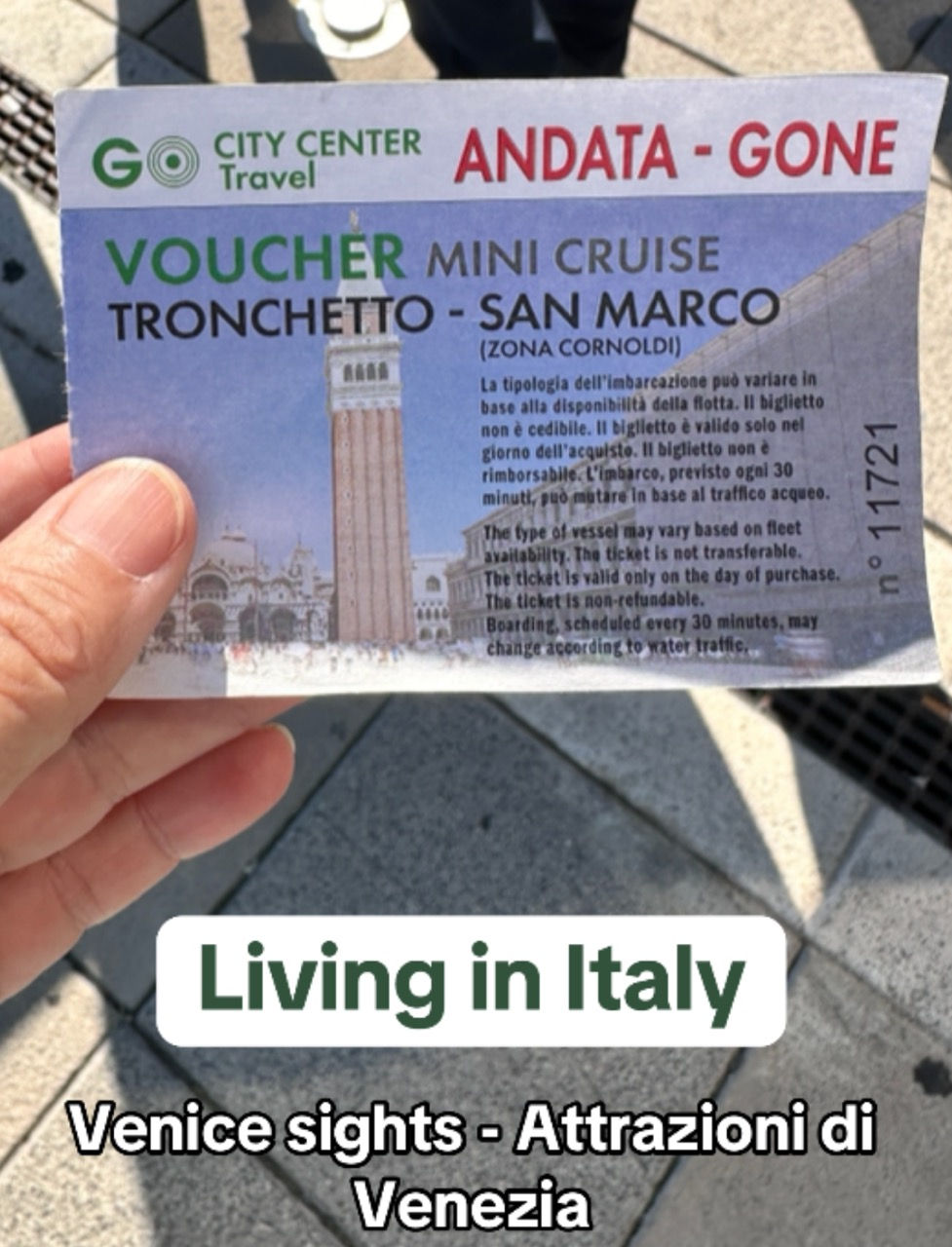


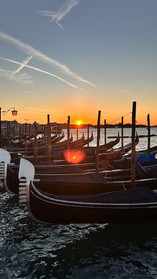



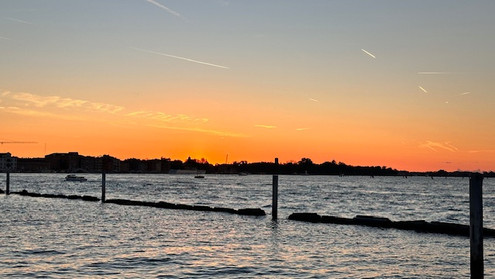







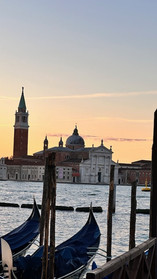





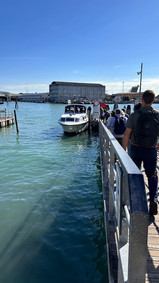















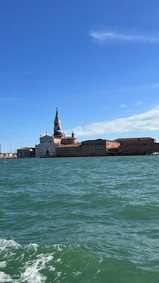





















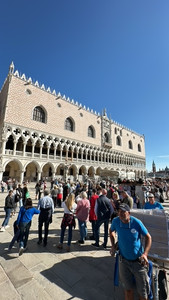



























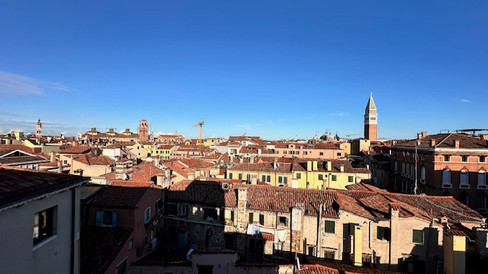















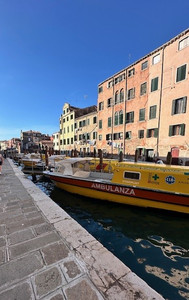


























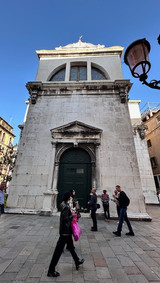





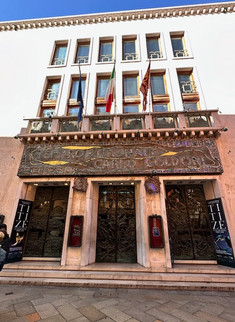







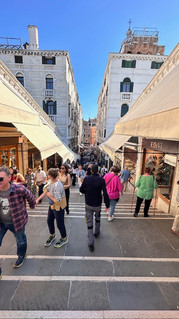













Comments